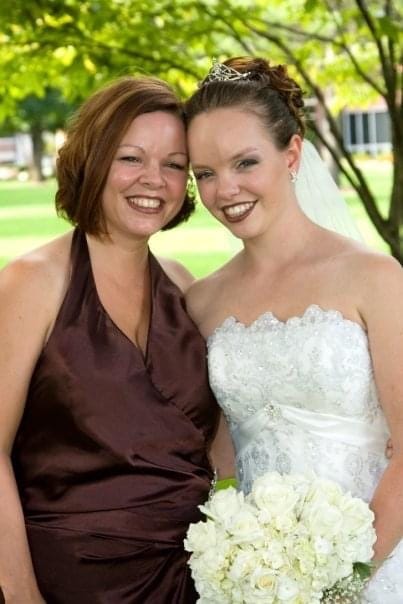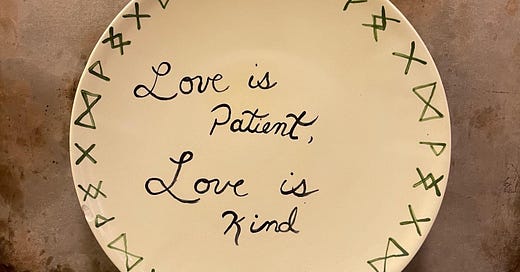THE PLATES
"On those Tuesday nights in ceramics class, she talked to me as a peer; it was the start of [our] mother-daughter friendship...."
When I was 13, in the mid-’90s, my mom and I took a ceramics class together. Every Tuesday night for several months, we’d leave my dad and three brothers at home and head out, just the two of us. Mom was an artist, though she always downplayed it as a hobby. She painted mostly on canvas but also on furniture she found on the side of the road. Our house was her gallery, filled with her oil paintings and soft pastel portraits of my brothers and me. She was forever rearranging the furniture to match her evolving creative vision, much as she changed her hair from platinum to chocolate, straight to curly, long to short. She was a free spirit.
She was tiny—5’1”—but she had big, magnetic energy. Her love language was practical jokes. She once baked her brother-in-law a pie filled entirely with apple cores. For her best friend’s birthday, she made a gorgeously decorated sponge cake composed of industrial-size yellow sponges. She took playing tricks on people as seriously as she took tarot cards and astrology.
On those Tuesday nights in ceramics class, she talked to me as a peer, sharing bits of her adult life—tiffs with her sister, struggles with my brothers, her latest idea for a painting; it was the start of a mother-daughter friendship that would blossom as I grew into young adulthood. Ceramics class is also where she made these plates, a set of 12 on which she wrote a version of the well-known Bible passage about the nature of love. (She wasn’t especially religious, but she was devoutly romantic.) The plates did not impress me; with her talent, I thought her capable of so much more. But as with everything, she had a vision.
With Mom at the center of our family's gravitational field, Thanksgiving and Christmas were big and festive—every aunt, uncle, cousin and grandparent in a 45-mile radius attending. Party dresses for me, Kahlua and milk for the adults, ice clinking in holiday-themed glasses. And the plates. After our raucous family was finally corralled in the dining room and everyone had found a seat, we would go around the table reading them aloud: “Love is patient, love is kind.” “And envies no one.” “Love is never boastful, nor conceited, nor rude.” And so on.
The plates worked themselves into our lives as if they’d always been family tradition. They were there through my parents’ divorce. They moved with us to new homes. When I married, at 25, they initiated my husband. They tortured my younger brothers during their teenage years when reading aloud about love was mortifying. After my older brother and I moved out, the plates welcomed us home for the holidays.
Mom’s sudden death, in 2009, crushed my brothers and me. She was 47, and her heart just stopped beating. The simplicity of it infuriated me, paralyzed us with grief. We were teenagers and young adults whose lives would go wayward in the years that followed. But before we could even think about life without her, we had to get through her funeral. We were supposed to deliver a eulogy, to sum her up in words. In a last-minute decision the night before the service, we summoned the plates, asking our stepfather to dig them out of the cabinet where they were biding their time, not expecting to be needed on a warm summer day.
Sitting clustered at the end of two church pews, we frantically shuffled the plates into their proper sequence, the clinking of the ceramic echoing off the high ceilings, our homemade church bells. Side by side, we walked to the front of the church and stood there, each with a pile of three plates shaking in our hands. We read them in order of our birth, around and around. An homage to our mom who believed in the power of love. A eulogy written in brushstrokes with her own hand. Her art and her children carrying her from this world to the next.
—Amanda Kernahan



Amanda Kernahan is a writer, host of the podcast Grief Trails and founder of a small business, RememberGrams. She is working on a memoir and lives with her family in Rochester, NY.
For a different reading experience, The Keepthings’ stories can also be read in their entirety on Instagram @TheKeepthings.
Have a story to share? Please see the complete submission guidelines, including photo guidelines, at TheKeepthings.com.







This is so beautiful and tender. I was shocked when I got to the age she was when she died. I felt the devastation. The specificity of your memoir-our hands shaking with three plates each--puts me in the pew. Thank you for sharing.
Wonderful piece. The pieces of them that we are able to keep help our loved ones continue to live in us. Some people who have not experienced this kind of loss may not understand that it brings us a feeling of closeness when we touch something they touched, or wore something they wore or drank something they would drink. For a brief moment in time it is like they are not gone.